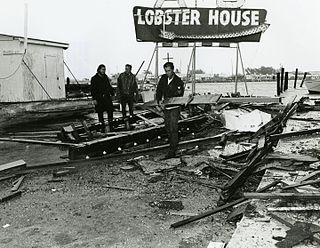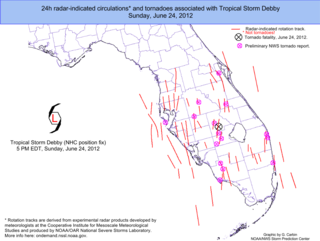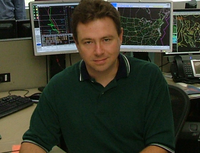The Fujita scale, or Fujita–Pearson scale, is a scale for rating tornado intensity, based primarily on the damage tornadoes inflict on human-built structures and vegetation. The official Fujita scale category is determined by meteorologists and engineers after a ground or aerial damage survey, or both; and depending on the circumstances, ground-swirl patterns, weather radar data, witness testimonies, media reports and damage imagery, as well as photogrammetry or videogrammetry if motion picture recording is available. The Fujita scale was replaced with the Enhanced Fujita scale (EF-Scale) in the United States in February 2007. In April 2013, Canada adopted the EF-Scale over the Fujita scale along with 31 "Specific Damage Indicators" used by Environment Canada (EC) in their ratings.

A meteorologist is a scientist who studies and works in the field of meteorology aiming to understand or predict Earth's atmospheric phenomena including the weather. Those who study meteorological phenomena are meteorologists in research, while those using mathematical models and knowledge to prepare daily weather forecasts are called weather forecasters or operational meteorologists.

A tornado watch is a statement issued by weather forecasting agencies to advise the public that atmospheric conditions in a given region may lead to the development of tornadoes within the region over a period of several hours. In addition to the potential for tornado development, thunderstorms that develop within the watch area may contain large hail, straight-line winds, intense rainfall and/or flooding that pose a similar damage risk as the attendant tornado threat.

A severe thunderstorm watch is a statement issued by weather forecasting agencies to advise the public that atmospheric conditions in a given region may lead to the development of severe thunderstorms within the region over a period of several hours. The criteria for issuing a watch varies by country, and may also include torrential rainfall and tornadoes. A watch may also be issued several hours ahead of the arrival of a mature and organized complex of storms, or more clustered or discrete storm activity.

Storm chasing is broadly defined as the deliberate pursuit of any severe weather phenomenon, regardless of motive, but most commonly for curiosity, adventure, scientific investigation, or for news or media coverage. A person who chases storms is known as a storm chaser.

The Storm Prediction Center (SPC) is a US government agency that is part of the National Centers for Environmental Prediction (NCEP), operating under the control of the National Weather Service (NWS), which in turn is part of the National Oceanic and Atmospheric Administration (NOAA) of the United States Department of Commerce (DoC).
This is a list of meteorology topics. The terms relate to meteorology, the interdisciplinary scientific study of the atmosphere that focuses on weather processes and forecasting.
Gandikota V. Rao was an Indian-American atmospheric scientist who chaired the Department of Earth and Atmospheric Sciences at Saint Louis University (SLU). He was a world-renowned expert on tropical meteorology, monsoon, tropical cyclones, and tropical cyclone tornadoes. He was also known for work on air pollution, atmospheric convection, atmospheric boundary layers, and numerical weather prediction.

Convective storm detection is the meteorological observation, and short-term prediction, of deep moist convection (DMC). DMC describes atmospheric conditions producing single or clusters of large vertical extension clouds ranging from cumulus congestus to cumulonimbus, the latter producing thunderstorms associated with lightning and thunder. Those two types of clouds can produce severe weather at the surface and aloft.

Robert H. "Bob" Johns was an American meteorologist specializing in severe convective storms and tornadoes.

The Verification of the Origins of Rotation in Tornadoes Experiment are field experiments that study tornadoes. VORTEX1 was the first time scientists completely researched the entire evolution of a tornado with an array of instrumentation, enabling a greater understanding of the processes involved with tornadogenesis. A violent tornado near Union City, Oklahoma was documented in its entirety by chasers of the Tornado Intercept Project (TIP) in 1973. Their visual observations led to advancement in understanding of tornado structure and life cycles.

On June 18–19, 1972, Hurricane Agnes generated the third-deadliest tropical cyclone-related tornado outbreak in the United States since 1900, as well as the deadliest such tornado outbreak on record in Florida. The outbreak lasted about 38 hours and produced at least 19 confirmed tornadoes, though some studies suggested nearly a dozen more. Two of the tornadoes killed a total of seven people and were not classified as tornadoes by the National Weather Service until 2018. In Florida alone, the outbreak inflicted at least 135 injuries and destroyed 15 homes, while 119 homes received damage. Statewide, 217 trailers were destroyed and 196 trailers incurred damage. Additionally, six businesses were destroyed, while six others were damaged.

Howard Bruce Bluestein is a research meteorologist known for his mesoscale meteorology, severe weather, and radar research. He is a major participant in the VORTEX projects. A native of the Boston area, Dr. Bluestein received his Ph.D. in 1976 from MIT. He has been a professor of meteorology at the University of Oklahoma (OU) since 1976.

From June 23 to 26, 2012, Tropical Storm Debby produced a significant tornado outbreak across the Florida Peninsula. Throughout the entire event, 25 tornadoes touched down across the state, making the outbreak the second largest on record in Florida, behind only that spawned by Hurricane Agnes, which produced 28 tornadoes from June 18 to 19, 1972. At least ten of the tornadoes—the largest 24-hour total in South Florida since Hurricane Isbell produced eight in 1964—had been confirmed in four South Florida counties by the National Weather Service forecast office in Miami.
The European Storm Forecast Experiment, known as ESTOFEX, is an initiative of a team of European meteorologists, and students in meteorology founded in 2002. It serves as a platform for exchange of knowledge about forecasting severe convective storms in Europe and elsewhere. It is a voluntary organisation and is currently unfunded. It aims to raise awareness and provide real-time education about severe weather forecasting. ESTOFEX issues storm warnings on a daily basis. It also collects reports from the general public about severe convective weather incidents in order to validate its forecasts. Reports should be submitted to the European Severe Weather Database (ESWD).
The following is a glossary of tornado terms. It includes scientific as well as selected informal terminology.

Donald W. Burgess is an American meteorologist who has made important contributions to understanding of severe convective storms, particularly tornadoes, radar observations and techniques, as well as to training other meteorologists. He was a radar operator during the first organized storm chasing expeditions by the University of Oklahoma (OU) in the early 1970s and participated in both the VORTEX projects.

Alan Roger Moller was an American meteorologist, storm chaser, nature and landscape photographer known for advancing spotter training and bridging operational meteorology with research.

On October 3–4, 1964, Hurricane Hilda and its remnants generated a tornado outbreak over portions of the Southeastern United States. The outbreak, which yielded at least 12 confirmed tornadoes, killed 22 people and injured 175 others. Most of the casualties occurred as a result of the 1964 Larose tornado that devastated the northern outskirts of Larose, Louisiana, becoming the deadliest hurricane-generated tornado on record since 1900 and one of only two violent tornadoes (F4+) recorded in the southern Gulf Coast region of Louisiana. The tornado was also one of only two F4s known to have been produced by a tropical cyclone, the other having occurred during Hurricane Carla on September 12, 1961.

John E. "Jack" Hales Jr. was an American meteorologist specializing in severe convective storms and tornadoes.















